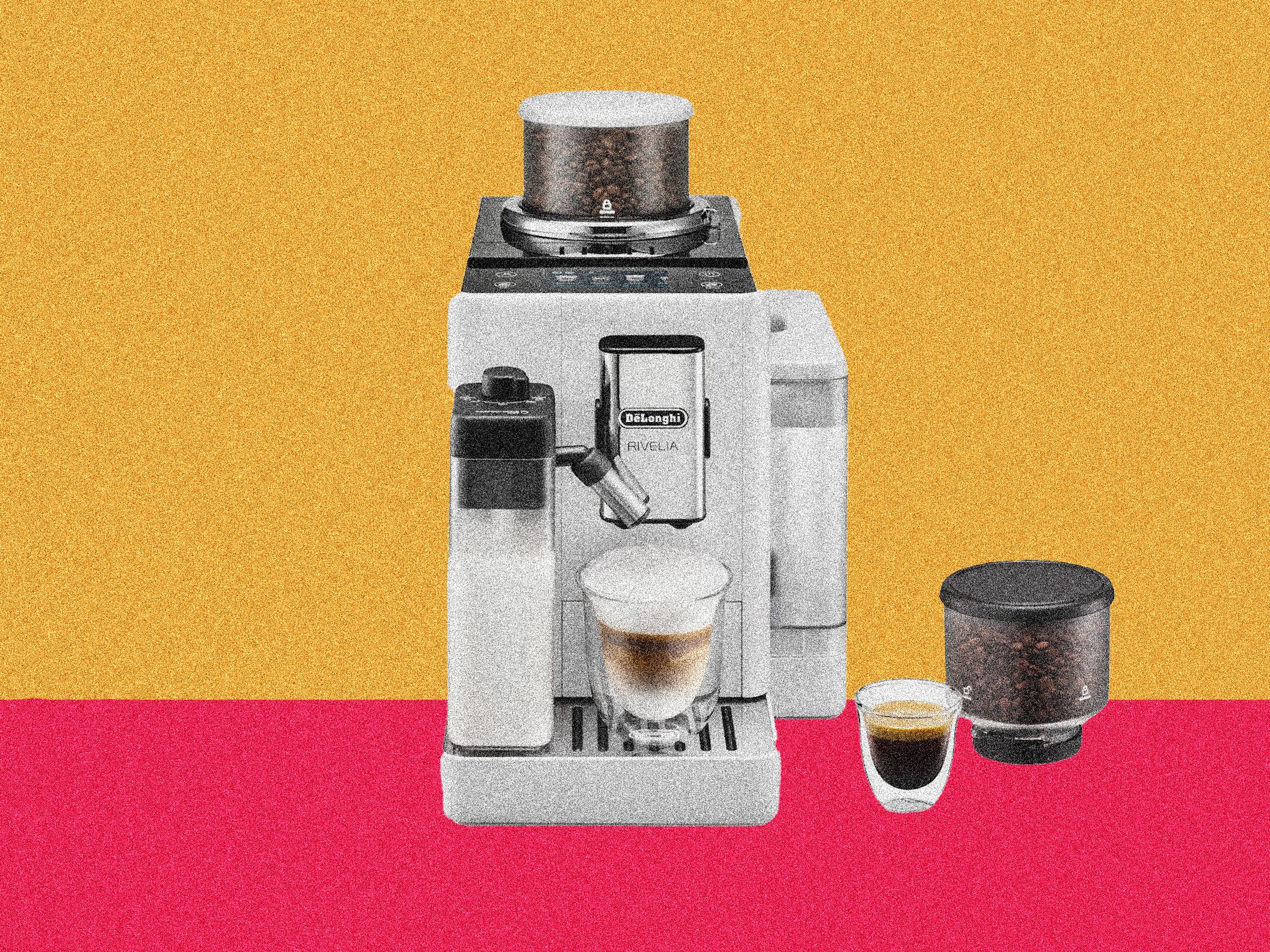There are maybe two schools of home espresso people. Some want it perfect, classic, maybe even a little difficult. They want to stick their hands in the gears and make fine adjustments, until the coffee is the most beauteous expression of its bean and its roaster. Some want it nice and easy, with maybe a little frothy milk in the bargain.
Photograph: De’Longhi
The new bean-to-cup Rivelia machine from Italian coffee titan De’Longhi, which arrived in the United States this month, is squarely meant for those who want it easy. Indeed, the Rivelia immediately ranks among the most modern, impressive, and capable super-automatic espresso machines I’ve seen—the sort that has you dump a half-bag of beans into a hopper, and will grind, brew, then froth up milk for a flat white with the press of a button.
The Rivelia’s crisply minimalist design and slim profile—less than 10 inches across—belies a whole lot of functionality. This includes an unholy array of 18 espresso and latte and iced-coffee drink options, a button-press milk frother that makes actual microfoam, and bean guidance that allows you to optimize your strength and grind for each bean. And yet despite the complicated options, the thing is pretty simple to use. I barely needed the manual.
Like Breville’s excellent Oracle Jet ($2,000), a more traditional pressurized-basket espresso machine that I’ve also been testing, the Rivelia is a device seemingly made for the generation that grew up with tablets and screens. About the only traditional button you’ll actually need is the on switch. Pretty much everything else happens on a touchscreen that remains blessedly impervious to a little water spillage.
Photograph: Matthew Korfhage
The Rivelia is self-consciously designed to be a friendly little machine, right down to the occasional uncanny use of the first person. “I’ll use some hot water to heat everything up,” reads the screen as you turn the machine on, moments before twin jets of water spurt into the drip tray.
The onboard computer will save profiles for up to six coffee beans, which mostly means you won’t have to memorize which of the 14 grinder settings you chose for your Indonesian or Peruvian beans when swapping them out. Drinks include a dizzying array of latte, cappuccino, cortado, flat white, espresso, long, lungo, and something just called “coffee.” Basically, you just swipe left or right through a little display of pictogrammed drink possibilities. Press the image of the drink of your dreams, and the machine does most of the rest, assuming you’ve already got your grinder set how you like it.
It’s hardly perfect, of course. The espresso from bean-to-cup machines is not the same substance you’d get from an espresso machine with a pressurized portafilter. And the $1,500 price tag is also nothing to sneeze at. But the Rivelia also feels like a big leap forward for De’Longhi’s bean-to-cup machines.
Hop to It
Photograph: De’Longhi
One of the most welcome and distinctive features on the Rivelia is the ability to swap beans back and forth at will. In theory, it shouldn’t be difficult to swap out one coffee bean for another on thousand-dollar espresso machines whose whole point is that they’re easy to use. But unlike single-dose espresso machines with separate grinders, bean-to-cup machines draw from large hoppers full of beans. Swapping them out before the hopper’s empty can be a hassle.
The problem, on most machines with built-in grinders, is retention. Even if you reach in your grubby fingers to scoop out one set of beans from a hopper and pour in the new bag, a bit of beans always stays trapped in the gears. You’re stuck dealing with these beans somehow. This means making a weird diluted half-drink, mixing your beans, or blasting out half a portafilter’s worth of bean grounds before making a new cup. It’s nothing you want to do daily—and it makes it a bit of a process to switch to decaf in the afternoon.
The Rivelia has a nifty little bean swap system that lets you uncork one hopper full of beans and swap in a second, with minimal fuss and no mixing of beans. It works like this: When you turn the bean hopper to the unlock position, the Rivelia’s screen will simply ask you what you want to do with the excess beanage, which amounts to around 5 grams, or half a shot.
You can choose to get a mini-drink from the excess, or ask the Rivelia to dispose of your little bean problem, sight unseen and no questions asked. Then, just swap out one color-coded bean hopper for the other, and here you are drinking decaf instead of your morning rocket fuel.
The bean swap is a simple and deft solution to an irritating problem that has dogged bean-to-cup machines since their inception. It’s also indicative of the thoughtfulness of this device overall.
Easy, Button-Press Customization
Swapping out beans is all well and good, but how’s the coffee? The answer isn’t straightforward. Bean-to-cup machines like the Rivelia, and other De’Longhi models like the Magnifica Evo ($650) and Dinamica ($1,300), exert just as much pressure as a traditional espresso machine. But they also tend to grind a little less finely than espresso made with a pressurized portafilter.
This coarser grind makes the resulting cup a whole lot less finicky, and less likely to be overbitter or deeply acidic, but also less intense. It’s a smooth cup, with some of the edges shaved off. It’s perfect for those who’d like to just press a button and be ensured a frothy cappuccino without looking at pressure gauges or worrying they’ll botch a shot completely.
Photograph: Matthew Korfhage
And so the Rivelia won’t rival a more difficult, fussier portafilter machine. But it does make cups as good as any bean-to-cup maker I’ve tried, in part because of its helpful “bean adapt” function. The machine can be programmed with up to six different bean profiles. When you want to add a new bean, the machine will have you put it through the paces.
To set the right temperature, the machine will simply ask you whether you’ve got arabica or robusta beans, and whether the roast is light, dark, or medium. Then, you’ll make a sample espresso shot, and the Rivelia will ask you how you like the strength. Based on the espresso’s flow rate, the Rivelia will also suggest a new grinder setting or tell you yours is already perfect.
Generally, the Rivelia will suggest a grind setting one up or one down from the one you just used, which may or may not get you all the way there. You’ll have to use your own taste buds to decide whether you need to “refine” yet again until your grind setting is correct. Once you settle on the result, the machine will remember the intensity and correct grind setting for each bean. Each time you swap beans, the screen will ask you to move your grinder dial to the appropriate setting. The results, to my taste buds, have been pretty accurate: I’ve not improved the taste by deviating.
Photograph: Matthew Korfhage
Choosing among various types of drinks is also quite easy, though you may not easily parse the difference among some options like long, lungo, and “coffee” — each a variation on a long espresso shot. The “coffee” setting, I can vouch, is essentially a European cafe crema. This amounts to a frothily crema-topped and slightly more full-flavored drink than the Americano. It’s also my favorite non-milked drink on the machine.
Just don’t worry much about the iced options. Each makes a stronger version of the same espresso or “coffee” you’d otherwise make, but now the machine tells you how many ice cubes to put into your waiting cup to dilute and fast-chill the coffee. Some cold drinks call for eight ice cubes in your cup. Some call for six. This is all oddly specific, given that the size of these cubes is unspecified. The thing might as well just play “Ice, Ice, Baby.”
Anyway, as with a lot of iced hot coffee drinks, the result fares better with milk. Otherwise, it can be a bit bitter.
A Fine Froth
Photograph: De’Longhi
The last big selling point for the Rivelia is the milk frothing system: It’s easy. You don’t need technique or skill. You don’t need to think about how far to dip a steaming wand. And you also don’t need to worry about wasting milk, because unlike a classic steaming wand, only the milk that gets used in your drink gets heated.
The separable milk frothing container is lightweight plastic, and at first feels a little rinky-dink. But basically, if you put a bit of milk at the bottom and plug the frother into the Rivelia, the device will suck up cold milk through the tube, and froth and steam and heat essentially within the steaming wand itself.
This won’t lead to enormously hot milk, but the system is suprisingly good at making silky microfoam. If you empty your milk into a separate jug instead of letting it pour directly into your coffee mug, you may even be able to make credible latte art, if you already know how to make latte art.
Photograph: Matthew Korfhage
Note that the milk system is a bit of a bear to fully clean, once every week or so. This involves taking apart a bunch of little plastic things and soaking or dishwashering the milk residue out of them, then remembering how to put them back together. And the Rivelia can be a bit spattery in general, especially when hot steam goes barreling into your milky waiting mug.
Depending on the drink you’ve selected, you’ll either receive the thick and airy froth of a cappuccino, or the much denser microfoam suitable for a flat white or latte. Usually, you’ll receive a lot of it. This is a device that’s really geared to milk lovers.
Which is good, because again, it’s not a deeply nuanced or intense cup of espresso. The Rivelia is geared toward ease, speed, simplicity, and smoothness, with a big removable water reservoir that’s easy to fill and beans that are easy to swap. It’s a button-press machine that is, in fact, what a large number of people want out of a home espresso device. These include my own mother, who’s long been a fan of bean-to-cup De’Longhi devices for all of these reasons, and has kept her Magnifica XS ($600) in good repair for a decade.
The Rivelia just happens to be easier, more versatile, and more impressive than any De’Longhi bean-to-cup I’ve yet tried. If you’re already a fan of those, you’ll likely be an even bigger fan of this.



